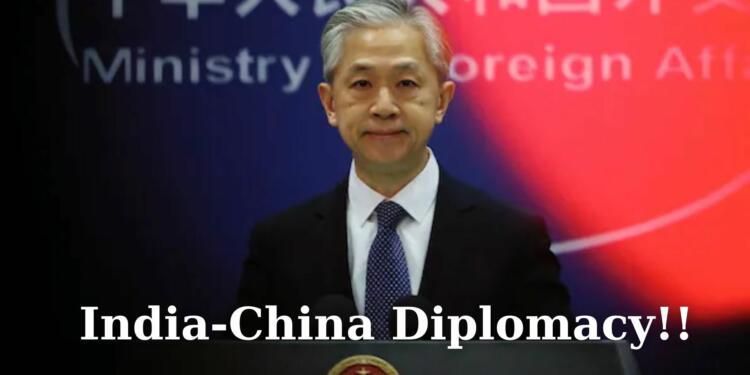The longstanding border dispute between India and China has garnered significant attention in recent years, particularly amid escalating tensions and military standoffs. However, amidst the challenges, there is a glimmer of hope as both nations express a shared commitment to finding a resolution. Chinese Foreign Ministry spokesperson Wang Wenbin’s recent statements underscore the mutual desire for an early settlement, highlighting the common interests at stake. Indian External Affairs Minister S Jaishankar echoes this sentiment, emphasizing the importance of resolving the issue for the benefit of both countries.
Historical Origins of the Border Dispute
The roots of the border dispute between India and China can be traced back to the colonial era and the subsequent partition of British India in 1947. The territorial demarcation between British India and Tibet, which was then a semi-autonomous region under Chinese suzerainty, was ambiguous and often disputed. This ambiguity laid the groundwork for future conflicts over the delineation of the border between India and Tibet (and by extension, China).
After the Chinese Communist Party came to power in 1949, it claimed sovereignty over Tibet, leading to tensions with India, which had established diplomatic relations with Tibet and had a vested interest in its autonomy. In 1950, China invaded Tibet, further complicating the border situation and triggering concerns in India about Chinese expansionism.
The Line of Actual Control (LAC) and its Challenges
The Line of Actual Control (LAC) was established following the 1962 Sino-Indian War, which resulted in a humiliating defeat for India and the occupation of territory by Chinese forces. However, the exact alignment of the LAC remains ambiguous in several areas, leading to frequent transgressions and disputes.
The rugged and inhospitable terrain of the Himalayas exacerbates the challenges of delineating the border accurately. Remote mountain passes, high-altitude deserts, and glaciated peaks make physical demarcation difficult, leaving room for differing interpretations and disputes over territory.
Additionally, the lack of mutually agreed-upon maps and boundary markers further complicates the situation, as both India and China have differing perceptions of where the LAC lies. This ambiguity has contributed to recurrent tensions and occasional military confrontations along the border.
Also Read: The Great AI Breach: Google, China, and the Stolen Secrets
Past Attempts to Resolve the Dispute
Diplomatic negotiations between India and China to resolve the border dispute have been ongoing for decades, with varying degrees of success. The 1962 war led to a brief period of hostility, but both sides eventually agreed to a ceasefire and began diplomatic discussions.
The 1993 Agreement on the Maintenance of Peace and Tranquility along the Line of Actual Control was a significant milestone in bilateral relations. It aimed to prevent armed conflict and maintain peace along the border through confidence-building measures, regular consultations, and the establishment of communication mechanisms between military authorities.
Subsequent agreements, such as the 1996 Agreement on Confidence-Building Measures in the Military Field, and the 2005 Agreement on Political Parameters and Guiding Principles for the Settlement of the India-China Boundary Question, further sought to manage the border dispute and pave the way for a peaceful resolution.
Despite these efforts, the border dispute remains unresolved, with periodic flare-ups and tensions continuing to characterize the India-China relationship. The lack of a mutually acceptable solution underscores the complexity and sensitivity of the issue, highlighting the need for sustained dialogue and diplomatic engagement to address historical grievances and chart a path towards lasting peace and stability.
Also Read: Jaishankar’s Sharp Wit: China’s Intentions Under Scrutiny
Recent Developments and Heightened Tensions
In recent years, tensions along the India-China border have escalated significantly, marked by military standoffs, clashes, and heightened rhetoric from both sides. One of the most notable incidents occurred in 2020, when Indian and Chinese troops engaged in a violent clash in the Galwan Valley, resulting in casualties on both sides. This incident, along with subsequent skirmishes in other areas along the Line of Actual Control (LAC), underscored the volatility of the border situation.
Military standoffs have become more frequent, with both sides accusing each other of crossing the LAC and violating territorial integrity. The deployment of additional troops, artillery, and military infrastructure along the border has further heightened tensions and raised concerns about the potential for escalation.
Factors Exacerbating the Dispute
Competing Territorial Claims: Both India and China assert sovereignty over certain areas along the border, leading to overlapping territorial claims and disputes over control of strategic locations. The lack of mutually agreed-upon borders exacerbates tensions and creates opportunities for conflict.
Strategic Interests: The border region holds significant strategic importance for both India and China, with access to natural resources, transportation routes, and military advantage at stake. Competition for influence in the region, particularly in the context of broader geopolitical dynamics, fuels tensions and exacerbates the dispute.
Historical Grievances: Historical grievances stemming from past conflicts, including the 1962 Sino-Indian War, continue to shape perceptions and attitudes towards the border issue. These lingering resentments contribute to mistrust and animosity between the two countries, hindering efforts to find a peaceful resolution.
Escalation of Tensions
Regional Stability: Heightened tensions pose a threat to regional stability, particularly in South Asia and the broader Indo-Pacific region. The risk of military conflict, even if localized, could have destabilizing effects and trigger broader regional security concerns.
Bilateral Relations: The border dispute strains bilateral relations between India and China, impacting diplomatic, economic, and cultural ties. Trust between the two countries has eroded, making cooperation on other issues more challenging and exacerbating existing differences.
Global Geopolitics: The India-China border dispute is situated within the broader context of shifting global geopolitics, including the rivalry between China and the United States. The escalation of tensions adds another layer of complexity to regional dynamics and could influence the strategic calculations of other major powers.
Path to Resolution
Recent statements by Chinese Foreign Ministry spokesperson Wang Wenbin and Indian External Affairs Minister S Jaishankar indicate a shared commitment to resolving the border issue, recognizing the common interests at stake. Both sides emphasize the importance of dialogue, communication, and adherence to existing agreements in achieving a peaceful resolution. It is crucial for both India and China to build upon these positive sentiments and engage in constructive diplomatic efforts to de-escalate tensions and find a mutually acceptable solution.
Exploring potential avenues for diplomacy is essential. This includes bilateral negotiations, where both parties can discuss their concerns and explore possible compromises. Third-party mediation, facilitated by neutral actors or international organizations, could also provide a platform for facilitating dialogue and building trust between India and China. Confidence-building measures, such as joint military exercises, information sharing mechanisms, and cultural exchanges, can help reduce misunderstandings and foster cooperation along the border.
Beyond the Border Dispute
While the India-China border dispute is a significant issue, it is essential to recognize the broader implications of the bilateral relationship. Economic cooperation between India and China has the potential to drive growth and prosperity in the region, benefiting both countries and contributing to global economic stability. Cultural exchange programs can promote mutual understanding and goodwill between the people of India and China, fostering a more positive atmosphere for diplomatic engagement.
Maintaining a comprehensive perspective on bilateral relations is crucial, as reducing the relationship to a single issue risks oversimplification and neglect of other important areas of cooperation. India and China share common challenges, such as climate change, global health crises, and economic development. By working together, they can leverage their combined resources and expertise to address these pressing issues and contribute to global efforts towards sustainable development and shared prosperity.
Enhanced cooperation between India and China requires political will, mutual respect, and a willingness to set aside differences for the greater good. By prioritizing dialogue, cooperation, and diplomacy, India and China can overcome the challenges posed by the border dispute and build a more stable, peaceful, and prosperous future for both nations and the wider region.
In conclusion, India and China demonstrate a shared commitment to resolving the border dispute for mutual benefit. Sustained dialogue, mutual trust, and cooperation are paramount in achieving a lasting solution. It’s imperative for both nations to seize the opportunity for peace, transcending the constraints of the dispute. By fostering constructive engagement and collaboration, India and China can pave the way for a stable, prosperous future, not only for themselves but also for the wider region. Let us embrace this opportunity and work together towards a peaceful resolution, ensuring a brighter tomorrow for generations to come.
Also Read: How Sela Tunnel Tilts the Scales? Giving Chills to China!































